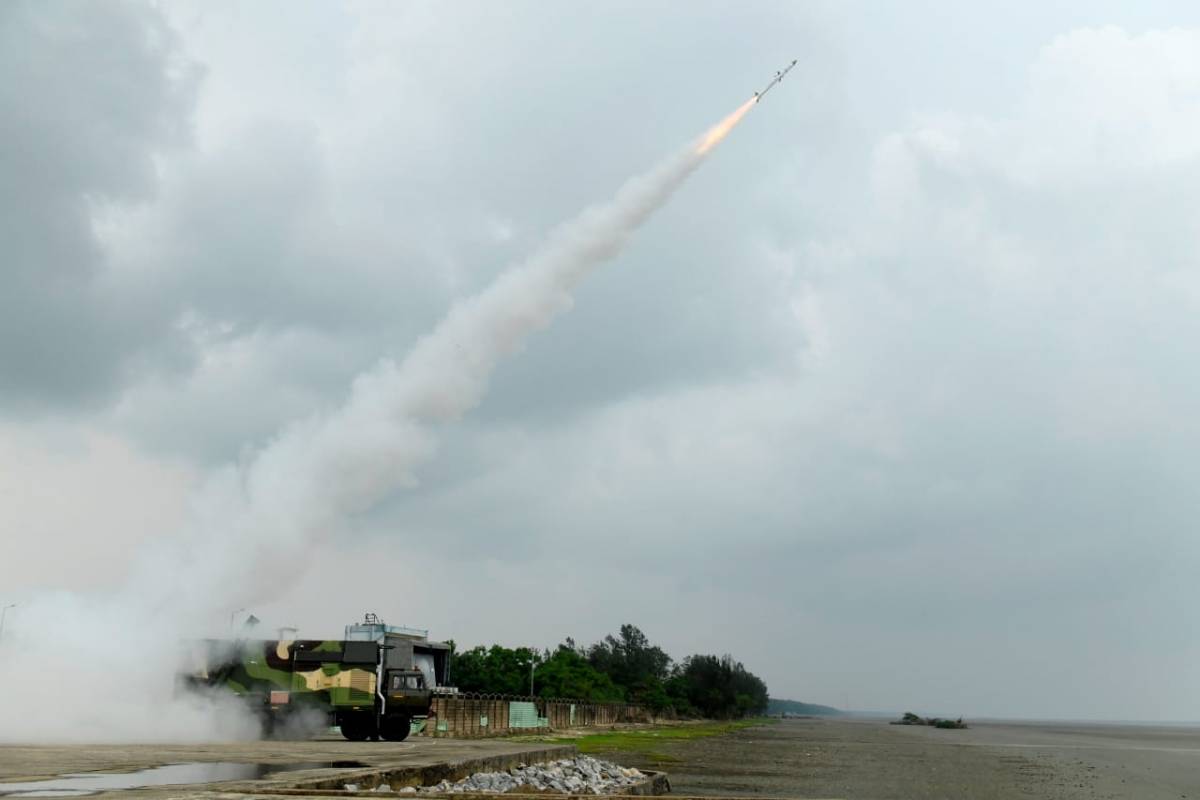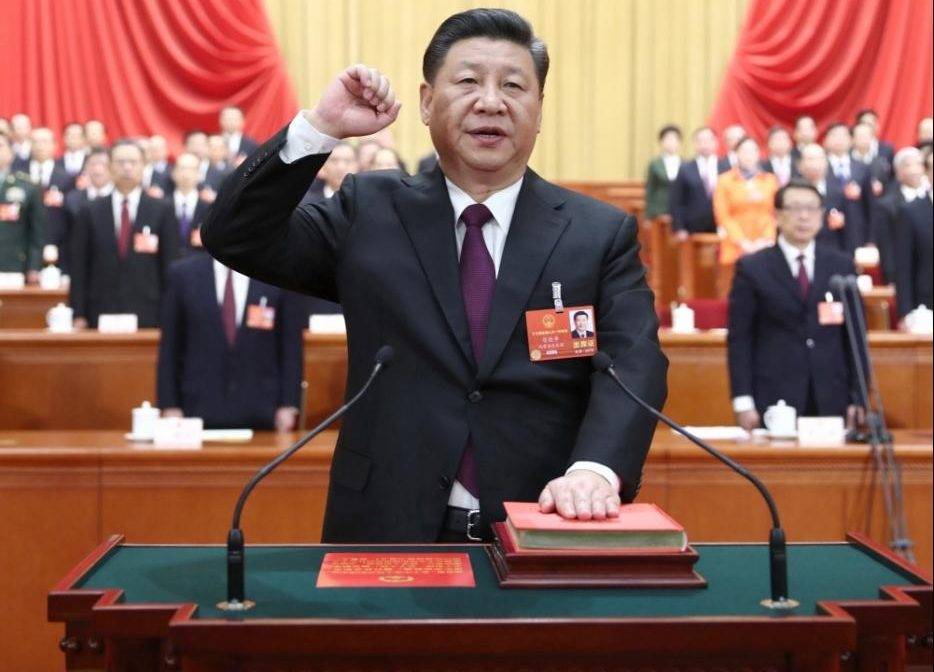The latest revelation on 12 August was by Roderick Lee from the China Aerospace Studies Institute, who uncovered a third silo field in Hanggin Banner in Inner Mongolia….reports Asian Lite News
Militaristic China is prioritizing the mass deployment of ballistic missiles. The country has secretively engineered vast missile silo fields able to host nuclear weapons, has ramped up nuclear production and deployed new shorter-range missile types.
The People’s Liberation Army Rocket Force (PLARF) controls China’s ballistic-missile arsenal, and this includes vast silo fields currently under construction from which to launch intercontinental ballistic missiles (ICBM).
To date, the open-source intelligence (OSINT) community has discovered three large missile silo sites deep inside China. The James Martin Center for Non-proliferation Studies at the Middlebury Institute of International Studies unearthed the first, an ICBM field of 120 silos near Yumen in the Gobi Desert, in late June.
Then, in July, Matt Korda and Hans Kristensen from the Federation of American Scientists announced the discovery of 110 missile silos near Hami in eastern Xinjiang.
The latest revelation on 12 August was by Roderick Lee from the China Aerospace Studies Institute, who uncovered a third silo field in Hanggin Banner in Inner Mongolia.

Construction on a grid layout similar to the other two had commenced by mid-May. Satellite imagery showed two clusters with 29 potential silos in total, of which 13 were sheltered by typical inflatable domes to cover sensitive construction details.
Lee estimated that the site would boast 30-36 silos at a minimum. Advantages of the Hanggin Banner site compared to Yumen and Hami are its proximity to ground-based fibre-optic communications nodes, and its shorter distance to the PLARF’s central warhead handling and storage facility in Taibai County, Baoji.
Of course, it is not confirmed that every new silo will indeed house a DF-41 ICBM, for some could be decoys, and actual missiles could be rotated around silos in a kind of shell game.
Realistically, the DF-41 is unlikely to contain more than six nuclear warheads per missile. However, if each silo did house a DF-41, then China’s projected inventory of ICBM launchers would equal the Minuteman-III ICBMs operationally deployed by the USA.
In addition, the PLA has nuclear missiles mounted on submarines and carried on
H-6 bombers and on the future H-20 stealth bomber. These silo discoveries reinforce what the US military has been alluding to in recent years about the fast expansion of Chinese strategic nuclear forces.
Many doubted the Pentagon’s assessment, but its descriptions have been well and truly vindicated.
Admiral Charles A. Richard, head of the US Strategic Command (STRATCOM), warned at the Space & Missile Defense Symposium in Huntsville, Alabama earlier this month,
“The explosive growth in their nuclear and conventional forces can only be what I describe as breathtaking. Frankly, that word ‘breathtaking’ may not be enough.”

The imminent expansion of China’s DF-41 ICBM arsenal is reinforced by a revelation that the China Nuclear Engineering and Construction Group Corporation Limited has received a fourfold expansion in military contracts in the first seven months of 2021 compared to last year.
The state-owned company reported on 18 August that it had been awarded CNY17.2 billion (USD2.65 billion) in military contracts this year to date.
China Nuclear Engineering and Construction engages in both civil and military nuclear projects. Its military engineering arm enjoyed a 332.4% year-on-year increase in May, and 302.2% in June.
This is well in accord with the discovery of missile silos, for facilities must be built first so that ICBMs can be installed later.
The South China Morning Post quoted Song Zhongping, a former PLA instructor: “The numbers indicate a trend of expanding our nuclear weapons and power systems, which come under the nuclear military engineering sector. It is necessary for us to expand our capabilities in this field in order to maintain national security on our own, as the United States is increasingly challenging China and interfering in China’s internal affairs more deeply.”
These silo field discoveries, with perhaps more on the way, indicate a fundamental transformation in China’s military and strategic posture. At the foundational level, it gives any would-be adversary a more challenging set of targets, simply because static sites have been multiplied more than twelvefold. Furthermore, these silos give the PLARF the ability to quickly launch missiles – in a retaliatory way only if Beijing’s No First Use policy is to be believed.
Admiral Richard of STRATCOM warned, “It really doesn’t matter why China continues to modernize. What matters is they are building the capability to execute any plausible nuclear employment strategy – the last brick in the wall of a military capable of coercion.”
One can authoritatively say that China has moved beyond minimum deterrence. Indeed, US Secretary of State Antony Blinken told a meeting of Asian foreign ministers in August “how Beijing has sharply deviated from its decades-old nuclear strategy based on minimum deterrence”.
The STRATCOM commander again: “China has correctly figured out that you can’t coerce a peer – in other words, us – from a minimum deterrent posture.” He said for the USA, “Business as usual will not work.” The USA’s new policy could be one of “integrated deterrence”, a concept to be explained in a forthcoming nuclear posture review.

Interestingly, Admiral Richard encouraged OSINT communities to continue their hunt for Chinese missile sites. He said, “If you enjoy looking at commercial satellite imagery or stuff in China, can I suggest you keep looking?”
This was a strong hint that more Chinese silo fields await discovery. In fact, some experts assess that discovery of the first 230 silos is perhaps only 30-40% of the full picture.
Until now, the PLARF possessed just 20 operational silos for DF-5 ICBMs. Eight new silos for the older DF-5 are thought to be under construction, plus new ones are being
built in Jilantai, likely for training.
Nor is China wholesale replacing older and less-capable ICBMs. For example, there is no evidence that older DF-31 and DF-31A ICBMs mounted on transporter-erector-launchers (TEL) are being withdrawn.
Decker Evelyth, the researcher who discovered the first missile silo field, offered some thoughts as to why the transformation in China’s nuclear posture caught so many by surprise: (1) Over-estimating bureaucratic inertia in Chinese strategic culture and organization/underestimating Xi’s goals and influence. Reading of reaction from Chinese experts/ex-PLARF people makes me think this is genuinely a shock to some of them; (2) Not appreciating how China’s shift from regional/non-peer power to global/near-peer power might influence nuclear posture; (3) Not appreciating how much thinking about national prestige and using nuclear weapons as symbols of state power might drive the program forward; and (4) Simple speed of change. I made an argument in my thesis about a gradual shift from assured retaliation to escalation or something else. I did not think things would accelerate so quickly.
There is speculation about China’s intentions for its ICBM arsenal. Thomas Shugart, an Adjunct Senior Fellow at the Center for a New American Security, suggested that perhaps the PLA is developing a large dual nuclear-conventional ICBM force that could strike the continental USA in time of war. A conventional DF-41 might thus be equipped with a large unitary high-explosive warhead (i.e. a single charge), or perhaps a warhead that carries precision-guided sub-munitions to cause damage over a wide area.

Certainly, despite all these new China Nuclear Engineering and Construction contracts, Beijing definitely could not quickly create enough fissile material to fill every silo with a nuclear warhead.
Using conventional warheads would help to fill out numbers, however. The Second Artillery Corps, the PLARF’s predecessor, has discussed in the past using conventional ICBMs to strike targets beyond the range of other missile types. Indeed, there have been subtle references to this in more recent documents as well. The circular error probable (a measure of accuracy) for such missiles could be in the single-digit meters, which means China can deliver such a conventional missile precisely even at intercontinental ranges.
Of course, using the same intercontinental ballistic missile for dual missions is fraught with risk, for a targeted country does not know whether a conventional or nuclear warhead is fitted. This could quickly rise to nuclear retaliation, even if China did not intend it.
This is one serious criticism of China’s dual-nature DF-26 intermediate-range ballistic missile, for example. However, the DF-26’s fielding shows that China is already comfortable with this ambiguous situation.
Meanwhile, Ma Xiu, an analyst at BluePath Labs, and Peter W. Singer, a strategist at New America, assessed that these silo fields might affect the PLARF’s order of battle.
They wrote: “The PLARF exploded in size between 2017 and 2019, growing more than 33% in only three years. Ten new brigades were added, with the six bases growing to accommodate them. However, the construction of two [now three] entirely new missile silo fields could make that existing structure inadequate. Assuming roughly 6-12 silos for a typical ICBM brigade, each field could easily require multiple brigades, even if only a fraction of silos were filled. Currently, all PLARF bases oversee between six and seven brigades and seem unlikely to grow much further. This means that each of these sites would likely be too large to fit within the existing force structure and could easily become a base in its own right. This would make them the PLA’s first new ballistic missile bases in over 50 years.”

Speaking at the same Alabama conference as Admiral Richard was General Glen D. VanHerck, commander of the US North American Aerospace Defense Command.
He reported that China had “just demonstrated” a “very fast” hypersonic vehicle, a reference
to a missile carrying a warhead that travels at hypersonic speed.
VanHerck said such warheads would challenge current US early-warning systems. He did not clarify whether this was a new type of hypersonic glide vehicle (HGV) or an existing one. China is known to already possess the DF-17 HGV, which was carried on a 10×10 TEL at a Beijing military parade in 2019.
Recently, a photo of a new type of missile carried by 12×12 TELs appeared on the Chinese internet. The missile body is longer than that of the DF-17, and it features a similar HGV warhead. It is not known if this was the type referred to by General VanHerck. Some speculatively call it the DF-27, but the identity of such a third- generation missile with sufficient range to reach Hawaii is by no means confirmed.
Any “leak” of such a photo is obviously sanctioned by the Chinese government.
Furthermore, Chinese state media reported on 22 August that China had successfully tested two new short-range conventional missiles. This new type can overcome “complex electromagnetic interference” to destroy facilities (e.g. enemy communications) in a “fast-reaction” operation.
Indeed, PLARF officers claimed such an operation now took half the time it did previously, and required involvement of fewer people. CCTV reported the missiles “successfully hit the target in an enemy camp equipped with multilayer defenses several hundred kilometers away and effectively paralyzed the enemy’s key communications node”. The outlet broadcast images of the live-fire drills in northwest China.
In a takeover of Taiwan, for example, China could attempt to first knock out communications and networks with a barrage of such missiles. Wu Shaomin, a senior engineer from the 1st Conventional Missile Brigade (a unit designation not previously known), noted, “Before we can gain control over the sea and air, we can use these kinds of missiles to destroy the enemy’s bases and then we can send over fighter jets, ships and amphibious vehicles.”
The CCTV report suggested that the missile is some kind of electromagnetic weapon. It is tentatively analyzed as a member of the DF-15 short-range ballistic-missile family that entered service in 1991. The modified DF-15A has a 600km range and carries a high- explosive warhead, the 725km-range DF-15B possibly adds a radar correlation terminal guidance system, and the DF-15C with earth-penetrating warhead appeared in 2013.
The new missile type could then be a DF-15D, but there is no confirmation of this yet. China denies there is any change in its strategic forces. But when it comes to China, one should look at what they do rather than listen to what they say. (ANI)









